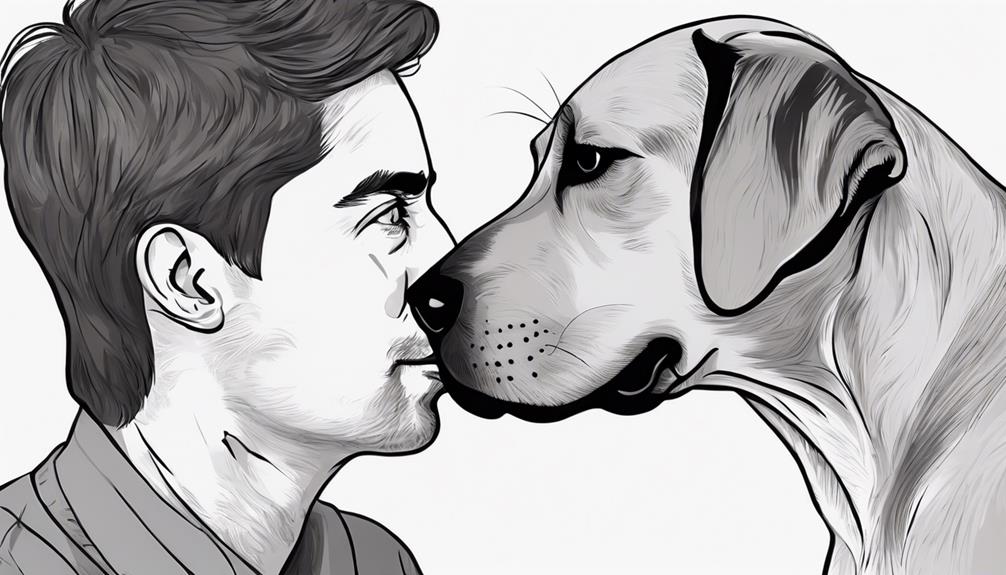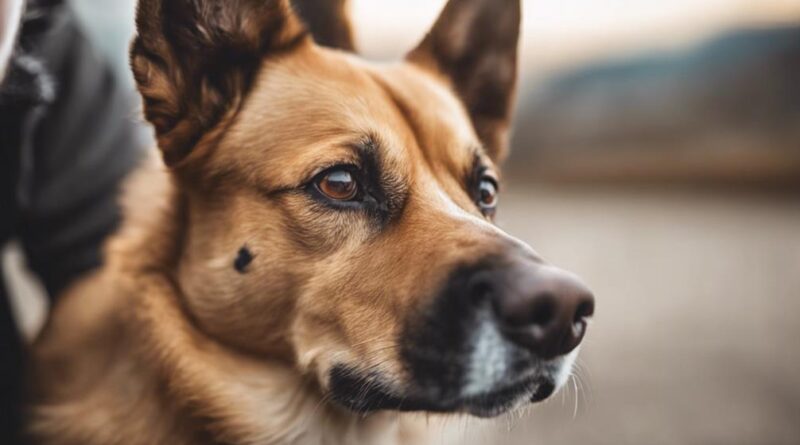What Does Eye Contact Mean in Dog Communication?
When your dog locks eyes with you, it's like they're speaking a silent language, isn't it?
The significance of eye contact in canine communication goes beyond mere staring.
Understanding the nuances of your dog's gaze can unveil a world of emotions and intentions that they are trying to convey to you.
So, next time your furry friend looks you in the eyes, remember, there's more to it than meets the eye – pun intended.
Importance of Eye Contact
Why is eye contact crucial in dog communication?
Eye contact plays a vital role in establishing a strong bond and connection with your furry companion. When you lock eyes with your dog, it shows them that you're present and attentive, fostering a deeper understanding and empathy between you both. Dogs are incredibly perceptive to human emotions, and maintaining eye contact can convey feelings of love, trust, and companionship.
Through eye contact, you can communicate your intentions to your dog more effectively. It helps in signaling to your pet that you're approachable and friendly, strengthening the emotional connection between you. Additionally, eye contact can be a powerful tool in training and discipline, as it allows you to assert your role as a leader in a gentle yet firm manner.
Types of Eye Contact
Making eye contact with your dog can be done in various ways, each conveying different messages and emotions. Understanding the types of eye contact and the nonverbal cues they represent is crucial in interpreting your furry friend's intentions.
In canine behavior, sustained eye contact can signal dominance or aggression. When a dog stares directly into your eyes without blinking, it may be asserting its position in the hierarchy or challenging your authority. On the other hand, brief and soft eye contact often indicates affection, trust, or submission.
Dogs also use eye contact to communicate their needs or desires, such as when they gaze at their food bowl or the door when they need to go outside. By paying attention to the type of eye contact your dog initiates, you can better comprehend their feelings and respond appropriately to strengthen your bond.
Positive Signals in Eye Contact
When your dog makes soft and gentle eye contact with you, it often signifies positive emotions such as trust and affection. This type of eye contact is a key element in understanding your dog's feelings and strengthening your bond with them.
Positive Signals in Eye Contact:
- Bonding Behavior: Soft eye contact from your dog can indicate a desire to bond with you. This bonding behavior is essential for building a strong and healthy relationship with your canine companion.
- Canine Companionship: Positive eye contact fosters a sense of companionship between you and your dog. It shows that your dog enjoys being in your presence and values your company.
- Nonverbal Cues for Social Interaction: Dogs use eye contact as a nonverbal cue to communicate and engage in social interaction with their human companions. Understanding these cues can enhance your communication and deepen the connection between you and your furry friend.
Negative Signals in Eye Contact
Negative signals in eye contact can indicate discomfort or aggression in your dog. When your dog engages in prolonged staring or maintains intense eye contact without blinking, it may be displaying dominance behavior or signaling aggression. These behaviors can be a way for the dog to assert its authority or challenge your position in the hierarchy. Additionally, if your dog averts its gaze, squints, or shows the whites of its eyes, these can be fear responses indicating that the dog is uncomfortable or anxious in the situation.
Aggression cues in eye contact can include a fixed gaze, raised fur, or a stiff body posture. On the other hand, submission signals like looking away, blinking frequently, or lowering the head can indicate that your dog is trying to avoid conflict and show deference. It's essential to pay attention to these negative signals in eye contact to understand your dog's emotional state and prevent any potential escalation of aggression or discomfort.
Misunderstandings in Eye Contact
Misunderstandings in eye contact can arise due to differences in communication styles between dogs and humans. Cultural differences play a significant role in how eye contact is perceived. Dogs may interpret prolonged eye contact as a challenge or threat, whereas in some human cultures, it signifies attentiveness or respect. This disparity can lead to misinterpretation and potential conflicts between dogs and their owners.
Key Points:
- Cultural Differences: Dogs and humans come from diverse backgrounds with varying norms surrounding eye contact. Understanding these differences is crucial to avoid misunderstandings.
- Nonverbal Cues: Dogs rely heavily on body language to communicate. While humans may use eye contact to convey affection or authority, dogs might perceive it differently based on their instinctual responses.
- Misinterpretation: Misunderstandings can occur when dogs misinterpret human eye contact. This can result in fear, aggression, or confusion, highlighting the importance of learning and respecting each other's communication styles.
Building Trust Through Eye Contact
To build trust through eye contact, focus on establishing a positive and consistent connection with your dog. Trust development and bonding techniques are crucial in this process. When engaging in eye contact with your dog, pay attention to their nonverbal cues and body language. Dogs are highly responsive to these subtle signals and can sense your intentions through eye contact. Maintain a soft gaze and avoid staring intensely, as this can be perceived as threatening.
Consistency is key in building trust with your dog. Make eye contact a regular part of your interactions, especially during moments of bonding such as playtime, grooming, or training. Use eye contact to reinforce positive behaviors and strengthen your relationship with your furry companion. By incorporating eye contact into your daily routine, you can create a strong foundation of trust and communication. Remember, eye contact is just one of the many ways to connect with your dog on a deeper level and build a lasting bond based on mutual understanding.
Training Techniques Using Eye Contact

When training your dog, utilize eye contact as a powerful tool to reinforce desired behaviors and strengthen your communication bond. Eye contact can significantly enhance your training sessions by improving focus and understanding between you and your furry companion.
Here are three effective training techniques using eye contact:
- Bonding exercises, obedience training: Establish a strong bond with your dog through eye contact during obedience training sessions. When your dog follows a command correctly, reward them with eye contact and praise to reinforce the positive behavior.
- Behavioral cues, attention redirection: Use eye contact to communicate behavioral cues to your dog. Direct your gaze towards the desired behavior you want your dog to exhibit, helping them understand what's expected. Additionally, if your dog is displaying unwanted behavior, redirect their attention through eye contact towards a more appropriate activity.
- Consistency and patience: Remain consistent in using eye contact as a training tool and be patient with your dog's progress. Over time, the bond between you and your dog will strengthen as you both learn to communicate effectively through eye contact.
Maintaining Eye Contact in Communication
Using eye contact consistently in your communication with your dog can strengthen your connection and improve mutual understanding. Dogs rely heavily on nonverbal cues to interpret emotions and intentions, and maintaining eye contact is a powerful way to convey your messages clearly.
When you engage in eye contact with your dog, it creates bonding moments that help establish trust and reinforce your relationship.
Frequently Asked Questions
Can Eye Contact With My Dog Indicate Their Level of Confidence or Anxiety?
When you make eye contact with your dog, it can show their level of confidence or anxiety. Dogs use eye contact as a form of communication. If your dog avoids eye contact, it could indicate fear or unease.
On the other hand, if they maintain eye contact with you, it might signal confidence or a desire to assert dominance. Paying attention to your dog's body language and social cues can help you better understand their feelings.
How Can I Tell if My Dog Is Uncomfortable With Prolonged Eye Contact?
If your dog is uncomfortable with prolonged eye contact, pay attention to their body language and canine behavior signals. Signs of discomfort may include:
- Averting their gaze
- Yawning
- Licking their lips
- Turning their head away
These actions can indicate that your dog is feeling uneasy or stressed by the eye contact. By being aware of these cues, you can respect your dog's boundaries and create a more positive interaction for both of you.
Are Certain Breeds of Dogs More Likely to Use Eye Contact as a Form of Communication?
Certain breeds exhibit unique tendencies in using eye contact as a form of communication. Some breeds, like Border Collies and German Shepherds, are known to use eye contact more frequently to convey messages. This behavior is rooted in their history as working dogs who relied on visual cues to coordinate tasks.
Understanding breed-specific communication signals is essential in decoding social interactions and interpreting canine behavior accurately.
Can Eye Contact Be Used as a Form of Discipline or Correction in Training?
When training your dog, eye contact can indeed be used as a form of discipline or correction. Maintaining eye contact can help reinforce commands and show your dog that you're in control.
However, excessive or aggressive eye contact can be perceived as a threat in dog communication. On the other hand, engaging in eye contact during play or bonding moments can strengthen your relationship with your furry friend.
Do Dogs Use Eye Contact Differently When Communicating With Humans Versus Other Dogs?
Dogs interact differently with humans and other dogs through eye contact. In dog behavior, eye contact with humans often signifies trust, affection, or a request for attention.
When communicating with fellow dogs, sustained eye contact may indicate dominance or aggression. Understanding these nuances in dog behavior and body language is crucial for strengthening the human-animal bond and navigating communication dynamics effectively.
Conclusion
In conclusion, eye contact plays a vital role in dog communication. It can convey positive signals such as bonding and trust, while negative signals can indicate fear or aggression.
Understanding the different types of eye contact and their meanings is essential for effective communication with dogs. By building trust through eye contact and incorporating it into training techniques, you can strengthen your relationship with your furry companion and enhance your communication skills.
